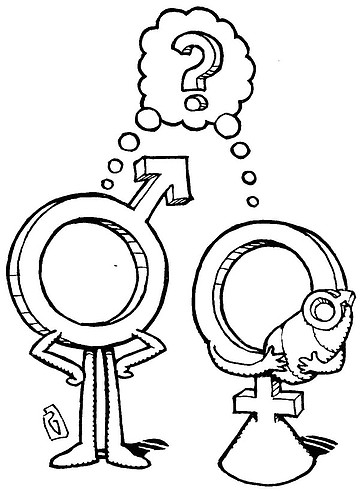 Facebook
Facebook
 X
X
 Instagram
Instagram
 TikTok
TikTok
 Youtube
Youtube

Heymatt:
When did people make the connection between sex and babies? How smart were we back in the Stone Age?
— Anonymous, via email
Anthropologists agree that we really don’t have much to go on to answer this question. No written records, of course, except cave paintings. By the time we could write things down, we had at least a broad notion of where babies come from. But lack of evidence doesn’t stop anthropologists from debating the subject. The consensus? At least 10,000 years ago. Late Stone Age. By then we’d learned to plant crops and raise herds of goats, sheep, and such. We’d domesticated gray wolves (puppy dog precursor) about 15,000 ago. To the science guys, it’s more likely that we got our first clue that sex = babies from watching other animals, not ourselves. The reasoning goes like this:

Human females are receptive to sex pretty much all the time. And pregnancy isn’t visually obvious until months after conception. So cause-effect doesn’t hit you in the brain quite as easily as it might in wild and domesticated animals. Female animals are sex receptive only during specific periods (estrus, it’s called), only a limited number of times a year. Heavy-duty mating activity during specific seasons in your goat herd followed by the birth of babies quickly teaches you that you need a herd of males and females, and all that mating stuff is good for your future as a farmer. We’ve found cave paintings of mating beasts, so it’s clear we noticed the animal goings-on and considered it significant in some way.
The details of the whole sperm-egg thing wouldn’t be discovered until we had microscopes in the 1800s. But the ancient Greeks were all over contraception. They devised natural plant potions they believed would prevent pregnancy. Many were high-acid or high-alkaline concoctions that well might have worked, though not reliably. One plant in ancient Greece was deemed so powerful a contraceptive, it was harvested into extinction shortly after it hit the market. That’s the best we’re likely to know about our Stone Age birds-and-bees situation.
Heymatt:
I think the percentage of left-handed people is about 20 percent, give or take a little. When I watch TV there seems to be many more than 20 percent of the actors who are left-handed. Why is this?
— BC, San Diego
I’m not going to critique your data-gathering technique. Let’s just say you’re right, that in a program with ten actors, at least three of them are lefties. Yes, on the face of it, that’s better than chance, so how did all those southpaws get on the tube? Left-handedness equals creativity, goes the old adage. There are long lists of leftie actors, painters, musicians, other creative folk. But this doesn’t tell us anything, really. Science can’t give you a specific answer, either. The best they can do is this: the left brain of righties is verbal, analytical, sequential, and sees the parts first, then the whole. The right-brain of lefties is visual, intuitive, and sees the big picture, then the details. The right brain functioning of lefties allows them to process words, emotions, and spatial relationships in more diverse ways than rigties. And science does venture the idea that left-handers are better at math and music. Professional orchestras often have a disproportionate number of left-handers, even on instruments that must be played with the right hand dominant, like violins. So, is your answer in there somewhere? I hope so, since that’s about it for scientific evidence. And I feel I should add that science has definitely proven that left-handers are no smarter than right-handers, despite what lefties think. Old-left-handed-wives’ tales don’t count.
“...where all the women are strong, all the men are good-looking, and all the children are above average.” — Garrison Keillor
Dear Matthew:
Are you average? Is Grandma Alice average? Is the average American tall? Fat? Red? Blue? Purple? Let’s face it, nobody wants to be seen as merely average.
—Your continued fan, Michael-Leonard Creditor, reader, photographer and thinker
Vague, inaccurate terms like “average American” only serve to lump people into unnecessary groupings. People, and other living things can not, and should not, be averaged; averages are for numbers. So, for example, instead of “The average American goes through 23.6 rolls per year,” you would write: “Americans use an average of 23.6 rolls of …yada yada.” OR, you could write, “On average, Americans consume….” Or, “On average, each person in the U.S. buys 23.... You get the idea. There are many other more correct ways to present the information. So, PLEASE, try not to average everybody from now on.


Heymatt:
When did people make the connection between sex and babies? How smart were we back in the Stone Age?
— Anonymous, via email
Anthropologists agree that we really don’t have much to go on to answer this question. No written records, of course, except cave paintings. By the time we could write things down, we had at least a broad notion of where babies come from. But lack of evidence doesn’t stop anthropologists from debating the subject. The consensus? At least 10,000 years ago. Late Stone Age. By then we’d learned to plant crops and raise herds of goats, sheep, and such. We’d domesticated gray wolves (puppy dog precursor) about 15,000 ago. To the science guys, it’s more likely that we got our first clue that sex = babies from watching other animals, not ourselves. The reasoning goes like this:

Human females are receptive to sex pretty much all the time. And pregnancy isn’t visually obvious until months after conception. So cause-effect doesn’t hit you in the brain quite as easily as it might in wild and domesticated animals. Female animals are sex receptive only during specific periods (estrus, it’s called), only a limited number of times a year. Heavy-duty mating activity during specific seasons in your goat herd followed by the birth of babies quickly teaches you that you need a herd of males and females, and all that mating stuff is good for your future as a farmer. We’ve found cave paintings of mating beasts, so it’s clear we noticed the animal goings-on and considered it significant in some way.
The details of the whole sperm-egg thing wouldn’t be discovered until we had microscopes in the 1800s. But the ancient Greeks were all over contraception. They devised natural plant potions they believed would prevent pregnancy. Many were high-acid or high-alkaline concoctions that well might have worked, though not reliably. One plant in ancient Greece was deemed so powerful a contraceptive, it was harvested into extinction shortly after it hit the market. That’s the best we’re likely to know about our Stone Age birds-and-bees situation.
Heymatt:
I think the percentage of left-handed people is about 20 percent, give or take a little. When I watch TV there seems to be many more than 20 percent of the actors who are left-handed. Why is this?
— BC, San Diego
I’m not going to critique your data-gathering technique. Let’s just say you’re right, that in a program with ten actors, at least three of them are lefties. Yes, on the face of it, that’s better than chance, so how did all those southpaws get on the tube? Left-handedness equals creativity, goes the old adage. There are long lists of leftie actors, painters, musicians, other creative folk. But this doesn’t tell us anything, really. Science can’t give you a specific answer, either. The best they can do is this: the left brain of righties is verbal, analytical, sequential, and sees the parts first, then the whole. The right-brain of lefties is visual, intuitive, and sees the big picture, then the details. The right brain functioning of lefties allows them to process words, emotions, and spatial relationships in more diverse ways than rigties. And science does venture the idea that left-handers are better at math and music. Professional orchestras often have a disproportionate number of left-handers, even on instruments that must be played with the right hand dominant, like violins. So, is your answer in there somewhere? I hope so, since that’s about it for scientific evidence. And I feel I should add that science has definitely proven that left-handers are no smarter than right-handers, despite what lefties think. Old-left-handed-wives’ tales don’t count.
“...where all the women are strong, all the men are good-looking, and all the children are above average.” — Garrison Keillor
Dear Matthew:
Are you average? Is Grandma Alice average? Is the average American tall? Fat? Red? Blue? Purple? Let’s face it, nobody wants to be seen as merely average.
—Your continued fan, Michael-Leonard Creditor, reader, photographer and thinker
Vague, inaccurate terms like “average American” only serve to lump people into unnecessary groupings. People, and other living things can not, and should not, be averaged; averages are for numbers. So, for example, instead of “The average American goes through 23.6 rolls per year,” you would write: “Americans use an average of 23.6 rolls of …yada yada.” OR, you could write, “On average, Americans consume….” Or, “On average, each person in the U.S. buys 23.... You get the idea. There are many other more correct ways to present the information. So, PLEASE, try not to average everybody from now on.
Comments